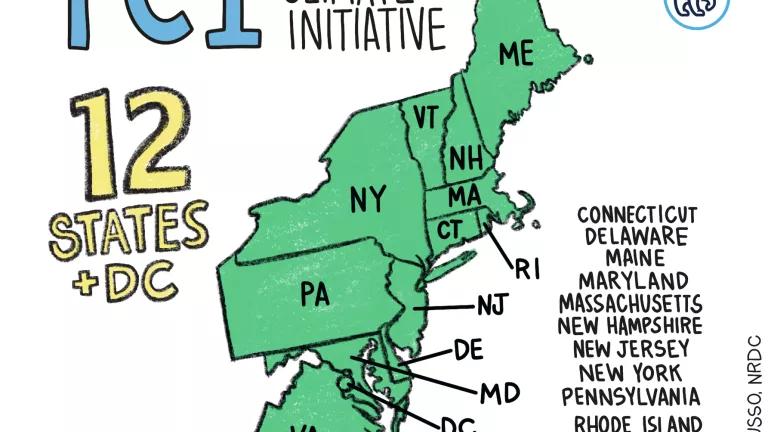New Health Study Shows TCI Clean Transit Program’s Potential
By cleaning up air pollution, making streets safer, and enabling healthier forms of active transportation, like walking, biking, and public transit, the Transportation and Climate Initiative program is projected to generate annual public health benefits of up to $11.1 billion by 2032, including by preventing 4,700 childhood asthma cases, 1,100 deaths, and other health harms from the current transportation system.

An independent team of public health experts from Harvard, Columbia, and other leading universities today released preliminary findings from extensive research conducted over the last year showing significant public health benefits from Northeast and Mid-Atlantic states’ proposed Transportation and Climate Initiative (TCI) clean transportation program. By cleaning up air pollution, making streets safer, and enabling healthier forms of active transportation, like walking, biking, and public transit, the TCI program is projected to generate annual public health benefits of up to $11.1 billion by 2032, including by preventing 4,700 childhood asthma cases, 1,100 deaths, and other health harms from the current transportation system. Today’s research shows these benefits would accrue in every county in the 12 states and District of Columbia region developing the TCI program.
This research shows that program ambition is key: adopting a stronger pollution cap and making smarter investments will maximize the TCI program’s benefits. The Harvard study shows that key program decisions could significantly affect the scale of the TCI program’s health benefits. Adopting an ambitious program that requires at least a 25 percent reduction in transportation carbon pollution over a decade and dedicating a larger share of TCI investment funds to public transit and active transportation programs is critical to maximizing the program’s benefits to the region. Doing so would also grow the program’s benefits in areas hardest hit by health-harming transportation pollution, though other measures will also be needed alongside TCI to address longstanding inequities.
How the TCI Program Would Work
The TCI program is a proposed “cap-and-trade-and-invest” program that would cut carbon pollution from transportation—the number one source of climate-disrupting pollution in the U.S.—across up to 12 states—Connecticut, Delaware, Maine, Maryland, Massachusetts, New Hampshire, New Jersey, New York, Pennsylvania, Rhode Island, Vermont, and Virginia—and D.C.
The program would work by setting the region’s first carbon cap—or limit on climate pollution—in the transportation sector and requiring oil companies that supply polluting gasoline and diesel fuels to reduce the pollution they cause over time. Oil companies would also be required to pay for the pollution their products cause, generating billions of dollars for investment in programs like improved public transportation in urban, rural, and suburban communities; safe, walkable and bikeable neighborhoods; emissions-free electric buses, cars and trucks; expanded access to broadband to enable telecommuting and remote services; and other innovative programs.
Achieving the Program’s Potential
The Harvard health study shows how critical the TCI program’s details will be in maximizing its benefits. Though still preliminary, this study is the most comprehensive look yet at the TCI program’s health potential, and it shows that decisions on the carbon pollution cap level and program spending will significantly influence outcomes.
The study shows unequivocally that a more ambitious transportation carbon cap—i.e., a cap that reduces pollution faster and by a greater amount—will lead to greater benefits. By requiring at least a 25 percent reduction in carbon pollution between 2022 and 2032, TCI states can achieve more than three times the health benefits of a program that reduces carbon pollution by only 20 percent. While the study shows health benefits would exceed program costs at both pollution reduction levels, the net benefits from the more ambitious 25 percent cap would exceed these costs by a greater margin, leading to greater social benefits.
The Harvard study also shows the critical role that TCI states' investment decisions will play. The research shows that investments in public transit and safe biking and walking infrastructure are projected to have the greatest health benefits—in terms of reduced childhood asthma cases, fewer premature deaths, and avoided respiratory hospitalizations from pollution—thanks to their ability to reduce health-harming pollution like soot and smog and facilitate healthy lifestyles through increased physical activity from active transportation.
Part of a Broader Suite of Solutions
Today’s health study builds on earlier research from the TCI states that likewise shows a well-designed TCI program could provide significant climate and health benefits while generating billions of dollars in economic growth (potentially $2.86 billion per year) and supporting thousands of new jobs (nearly 9,000 per year) in clean transportation and other industries.
But even the best TCI program, on its own, won’t solve all of the region’s, or individual states’, transportation challenges. As today’s study and previous research from the Union of Concerned Scientists and others show, our current transportation system is deeply inequitable.
Black and Brown and low-income communities in the TCI region and across the U.S. suffer from significantly higher rates of exposure to health-harming pollution from transportation and other sources, due to decades of systemic racism that has influenced where highways, ports, airports, bus and truck depots, and other polluting infrastructure is located. The Harvard study shows that a TCI program that adopts an ambitious pollution cap and prioritizes more equitable transportation investments could reduce these disparities, but it will not on its own solve them.
In a webinar last week, TCI states presented a series of proposed commitments to address equity under a TCI program, including a commitment that each participating state would ensure at least 35 percent of the program’s investment benefits accrue to underserved and overburdened communities; commitments to establish diverse equity advisory bodies in each jurisdiction to advise on implementation; and program transparency. The states also recognized the need to adopt and implement complementary policies alongside a TCI program to further ensure pollution reductions and transportation investments in the most impacted communities.
Later this year, Northeast and Mid-Atlantic governors and the mayor of D.C. will decide whether to move forward with a TCI program. Between now and then, it is critical that decision-makers continue to strengthen and articulate how they will ensure that the final TCI program and other programs states will pursue will address transportation inequity.
Today’s Harvard health study shows that a TCI program has the potential to achieve significant health benefits across the region. But working with communities to identify solutions, building guarantees into the final TCI program, and developing other complementary initiatives to maximize and ensure benefits are achieved will be key to the program’s ultimate success.



